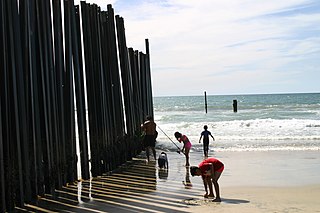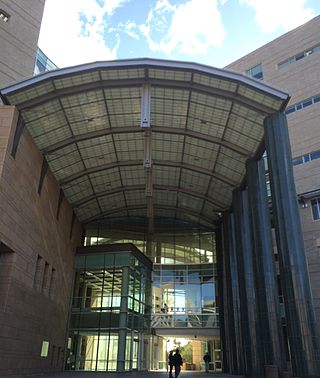Related Research Articles
Since 1945, immigration to the United Kingdom, controlled by British immigration law and to an extent by British nationality law, has been significant, in particular from the Republic of Ireland and from the former British Empire, especially India, Bangladesh, Pakistan, the Caribbean, South Africa, Nigeria, Ghana, Kenya, and Hong Kong. Since the accession of the UK to the European Communities in the 1970s and the creation of the EU in the early 1990s, immigrants relocated from member states of the European Union, exercising one of the European Union's Four Freedoms. In 2021, since Brexit came into effect, previous EU citizenship's right to newly move to and reside in the UK on a permanent basis does not apply anymore. A smaller number have come as asylum seekers seeking protection as refugees under the United Nations 1951 Refugee Convention.
Immigration detention is the policy of holding individuals suspected of visa violations, illegal entry or unauthorized arrival, as well as those subject to deportation and removal until a decision is made by immigration authorities to grant a visa and release them into the community, or to repatriate them to their country of departure. Mandatory detention refers to the practice of compulsorily detaining or imprisoning people seeking political asylum, or who are considered to be illegal immigrants or unauthorized arrivals into a country. Some countries have set a maximum period of detention, while others permit indefinite detention.

The Mexico–United States border is an international border separating Mexico and the United States, extending from the Pacific Ocean in the west to the Gulf of Mexico in the east. The border traverses a variety of terrains, ranging from urban areas to deserts. The Mexico–U.S. border is the most frequently crossed border in the world with approximately 350 million documented crossings annually. It is the tenth-longest border between two countries in the world.

Foreign nationals (aliens) can violate US immigration laws by entering the United States unlawfully or lawfully entering but then remaining after the expiration of their visas, parole, TPS, etc. Illegal immigration has been a matter of intense debate in the United States since the 1980s.
African immigrants in Europe are individuals residing in Europe who were born in Africa. This includes both individuals born in North Africa and Sub-Saharan Africa.

Illegal immigration is the migration of people into a country in violation of the immigration laws of that country or the continuous residence without the legal right to live in that country. Illegal immigration tends to be financially upward, from poorer to richer countries. Illegal residence in another country creates the risk of detention, deportation, and/or other sanctions.

Illegal entry is the act of foreign nationals arriving in or crossing the borders into a country in violation of its immigration law. Human smuggling is the practice of aiding people in crossing international borders for financial gain, often in large groups. Human smuggling is associated with human trafficking. A human smuggler will facilitate illegal entry into a country for a fee, but on arrival at their destination, the smuggled person is usually free. Trafficking involves physical force, fraud, or deception to obtain and transport people, usually for enslavement or forced prostitution.
The Canada–United States Safe Third Country Agreement (STCA) is a treaty, entered into force on 29 December 2004, between the governments of Canada and the United States to better manage the flow of refugee claimants at the shared land border.
Harragas, sometimes spelled Haraga are North African migrants who illegally immigrate to Europe or to European-controlled islands sometimes in makeshift boats. The term Harraga literally means “to burn” alluding to the migrants practice of burning their identity papers and personal documents in order to prevent identification by authorities in Europe. The North African men who partake in illegal migration refer to themselves as Harragas (burners).
Although it is difficult to measure how many people reside in the UK without authorisation, a Home Office study based on Census 2001 data released in March 2005 estimated a population of between 310,000 and 570,000. The methods used to arrive at a figure are also much debated. Problems arise in particular from the very nature of the target population, which is hidden and mostly wants to remain so. The different definitions of 'illegality' adopted in the studies also pose a significant challenge to the comparability of the data. However, despite the methodological difficulties of estimating the number of people living in the UK without authorisation, the residual method has been widely adopted. This method subtracts the known number of authorised migrants from the total migrant population to arrive at a residual number which represents the de facto number of unauthorised migrants.

Illegal immigration to Canada is the act of a person who is not a Canadian citizen or permanent resident entering or remaining in Canada in a manner contrary to the Immigration and Refugee Protection Act and its associated regulations. That includes persons who entered Canada on a travel visa but remained beyond the period of stay specified as well as persons who entered Canada without presenting themselves at a port of entry.
Illegal immigration to Australia is defined by the Migration Act 1958, which distinguishes between "lawful non-citizens" and "unlawful non-citizens".
Albanians in the United Kingdom include immigrants from Albania and ethnic Albanians from Kosovo. According to estimates from the Office for National Statistics, there are 21,000 Albanian nationals living in the United Kingdom as of 2021.

During 2015, there was a period of significantly increased movement of refugees and migrants into Europe. 1.3 million people came to the continent to request asylum, the most in a single year since World War II. They were mostly Syrians, but also included significant numbers of Afghans, Nigerians, Pakistanis, Iraqis, Eritreans, and the Balkans. The increase in asylum seekers has been attributed to factors such as the escalation of various wars in the Middle East and ISIL's territorial and military dominance in the region, as well as the Lebanon, Jordan, and Egypt ceasing to accept Syrian asylum seekers.

Operation Streamline is a joint initiative of the Department of Homeland Security and Department of Justice in the United States, started in 2005, that adopts a "zero-tolerance" approach to unauthorized border-crossing by criminally prosecuting those perpetrating it. Up to 70 people are tried at the same time, sometimes wearing shackles in the courtroom. Entering without inspection is a misdemeanor, and re-entering after deportation is a felony.

The Pembina–Emerson Border Crossing is a United States-Canada port of entry (POE) that connects the U.S. city of Pembina, North Dakota and the Canadian community of Emerson, Manitoba. On the American side, the crossing is connected by Interstate 29 (I-29) and U.S. Route 81 in Pembina County, while the Canadian side is connected by Manitoba Highway 75 in the Municipality of Emerson – Franklin.
An increasing number of refugees and migrants have been entering the United Kingdom illegally by crossing the English Channel in the last decades. The Strait of Dover section between Dover in England and Calais in France represents the shortest sea crossing, and is a long-established shipping route. The shortest distance across the strait, at approximately 20 miles, is from the South Foreland, northeast of Dover in the English county of Kent, to Cap Gris Nez, a cape near to Calais in the French département of Pas-de-Calais.
Migration and asylum policy of the European Union - is a policy within the area of freedom, security and justice, established to develop and harmonise principles and measures used by member countries of the European Union to regulate migration processes and to manage issues concerning asylum and refugee status in the European Union, in particular in the Schengen Area.

Roxham Road is a 5-mile (8.0 km) rural road from the former hamlet of Perry Mills in the town of Champlain, New York, United States, generally north to the vicinity of the former hamlet of Bogton, in the municipality of Saint-Bernard-de-Lacolle, Quebec, Canada. It has existed since the early 19th century, before the Canada–United States border was formally established along the 45th parallel north between the St. Lawrence and Connecticut rivers. For most of its length it is a rural two-lane blacktop; north of Parc Safari, it is also part of Quebec Route 202.
Externalization is efforts by wealthy, developed countries to prevent asylum seekers and other migrants from reaching their borders, often by enlisting third countries or private entities. Externalization is used by Australia, Canada, the United States, the European Union and the United Kingdom. Although less visible than physical barriers at international borders, externalization controls or restrict mobility in ways that are out of sight and far from the country's border. Examples include visa restrictions, sanctions for carriers who transport asylum seekers, and agreements with source and transit countries. Consequences often include increased irregular migration, human smuggling, and border deaths.
References
- ↑ Yamamoto, Ryoko (2007). "Crossing Boundaries: Legality and the Power of the State in Unauthorized Migration: Legality and the Power of the State in Unauthorized Migration". Sociology Compass. 1 (1): 95–110. doi:10.1111/j.1751-9020.2007.00027.x.
- ↑ "Irregular migration in the UK" Institute for Public Policy Research 2006 https://www.ippr.org/files/images/media/files/publication/2011/05/irregular_migration_1493.pdf?noredirect=1
- ↑ "Is it legal to cross the U.S. border to seek asylum?". International Rescue Committee (IRC). 1 March 2019. Retrieved 10 February 2022.
- ↑ "irregular migration". ec.europa.eu. Retrieved 10 February 2022.
- ↑ FitzGerald, David Scott (2019). Refuge beyond Reach: How Rich Democracies Repel Asylum Seekers. Oxford University Press. p. 167. ISBN 978-0-19-087417-9.